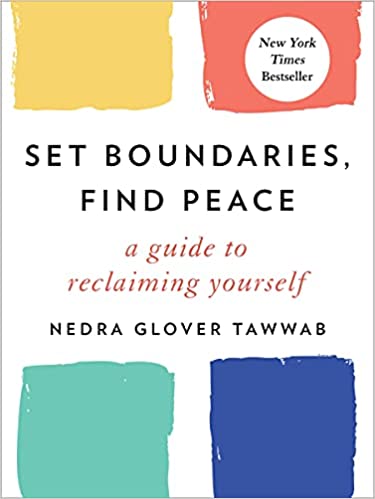Set Boundaries, Find Peace — Book Summary
Introduction
Nedra Glover Tawaab sets a clear precedent in relationships with this book. This book teaches how to secure your own peace by ensuring you understand how to set your own boundaries. It is a practical guide that will have you inspired with every page you turn.
Interesting quotes from the book
We don't naturally fall into perfect relationship; we create them
— Nedra Glover Tawwab, Set Boundaries, Find Peace
Tell people what you need.
— Nedra Glover Tawwab, Set Boundaries, Find Peace
Whose standard am I trying to meet? Do I have the time to commit to this? What’s the worst thing that could happen if I don’t do this? How can I honour my boundaries in this situation?
— Nedra Glover Tawwab, Set Boundaries, Find Peace
Summary of the book Set Boundaries, Find Peace
Boundaries are expectations and help you feel safe and comfortable in your relationships. They help you stay mentally and emotionally well. Not having boundaries can result in stress and burnout, and the first chapter explains some signs that come with not having boundaries. These are: neglecting self-care, feeling overwhelmed, feeling resentment for being asked for help, avoidance of people, and so on. It talks about three levels of boundaries: porous or weak boundaries, rigid boundaries, and healthy boundaries.
When you see your boundaries through communication and action, people react to them in many ways. These include pushback, limit testing, ignoring, rationalizing and questioning, defensiveness, ghosting, silent treatment, acceptance. Then the chapter ends by mentioning the areas where boundaries are sorely needed, such as family, friendships, and technology.
Chapter Two begins with a breakdown of what happens when we do not set boundaries. It tells the story of a woman who found it hard to set boundaries and shows possible solutions to the boundary problem the woman had.
Boundaries also have an integral relationship with a person's mental health. How do boundaries relate to anxiety? How does it cause depression? The chapter explains it. It also talks about the link between anxiety and Dependent Personality Disorder (DPD) and Borderline Personality Disorder (BPD). Relationships without boundaries can be a torrid time, and they can lead to anger, resentment, and frustration. Deep down, we know this, but setting boundaries is hard, so sometimes, instead of setting much-needed boundaries, we do other things such as a move away, complaint, gossip, cutting off people, and so on.
Since we know about the bad effects of not setting boundaries, what is stopping us from setting healthy boundaries? The next chapter attributes it to things such as misinterpreting what boundaries are, "it's them, not me" and the previous failure at setting a boundary. We may also notice at many points in our life that we have boundary issues and that setting boundaries are greatly needed, but we often tolerate these boundary issues for many different reasons such as the fact that we may not know that we need to set boundaries or the fact that we focus on the worst-case scenario or the fact that we may feel that we may not be able to tolerate the discomfort of setting boundaries. Where do we learn about boundaries? According to the chapter, we learn about boundaries from family at a very young age. It also teaches us about how to respect children's boundaries.
The next chapter teaches us types of boundaries. There are physical boundaries, sexual boundaries, intellectual boundaries, emotional boundaries, material boundaries, and time boundaries.
How do you know when your boundary has been violated? The chapter divides boundary violations into 'little b' and Big B' violations. Little "b", or micro boundary violations are small violations that often occur in everyday encounters, as opposed to long-term relationships. When a stranger at a party talks to you for 30 minutes, and you can't get in a word, it's a micro boundary violation. Big "B" violations on the other hand, which are also called macro boundary violations, are big violations that erode the fabric of our relationships with others, such as when you constantly have to rescue a friend with a drinking problem. The chapter also explains what microaggression is (this is usually how a micro boundary violation is expressed). Other examples of micro boundary violations include oversharing and guilt-tripping. Microaggressions include enmeshment, co-dependency, trauma bonding, and counter dependency.
So how do you communicate your boundaries? The chapter answers the question, but it begins with how NOT to communicate boundaries. Communicating boundaries in an aggressive, passive, passive-aggressive, or manipulative manner is not a good way to communicate boundaries. Assertiveness is the correct way. The chapter gives a step-by-step guide on how to be assertive and effectively communicate your boundaries. It also talks about what to avoid when setting boundaries. Never apologize for setting boundaries, don't waves, and don't say too much.
Blurred boundaries happen when a person isn't explicitly clear about what he wants, needs, or expects from the other person. A person usually has blurred boundaries when they gossip about their people, tell others about how they should live their lives, and so on. Restating boundaries, reducing interactions, and issuing ultimatums help in clarifying blurred boundaries. When people still do not respect our boundaries, it might be the best idea to cut them off. In a relationship, the boundaries of the two people can clash, and the book tells us that an understanding compromise is the best way to solve this problem.
The next chapter talks about trauma and boundaries. Trauma often limits the ability of people to set or notice boundaries, and boundary violations through trauma may be physical, sexual, or emotional. Trauma also impacts the way we get attracted to people, whether in an anxious manner, avoidant or secure. Shane and guilt after trauma can also cause someone to become rigid and set a rigidly unhealthy boundary.
The next chapter talks about setting boundaries with yourself, reducing the bad things we do that impact us negatively. Self-boundaries are imposed for the purpose of helping in the areas of finances, time-management, self-care, and so on, even down to the people one lets into one's life.
In the end, a big part of your wellness hinges on your boundaries.
You deserve to set boundaries for yourself and do things that don't make you feel uncomfortable.
Key Lessons from the Book
Lesson 1: Set Boundaries even when you feel least confident
You deserve to set boundaries for yourself and do things that don't make you feel uncomfortable. Setting boundaries, even when scared or feeble, makes you feel happier and more in control of your own life.
Lesson 2: Stick To The Boundaries You Set.
As you set boundaries with others, a couple of people may try to talk you out of it, or even manipulate you to drop your boundaries, but you must stand firm in your decision and stick to your boundaries.
Lesson 3: Set Boundaries For Yourself
It takes consciousness and discipline to set boundaries with others and keep them, it takes even more to keep them when it comes to yourself. Ensure you do so and be deliberate about it. This is some of the best self-care you can give to yourself.
Review of the book Set Boundaries, Find Peace
I found the book very practical and relatable. The fact that there were scenarios in them that I could relate to made the book even more awesome for me. It was an emotional read, seeing a lot of my thought processes here in print. I am definitely re-reading this!
Conclusion
With the inclusive and relatable tone in this particular book. There is hardly anyone I wouldn't recommend this great read to. If you have issues setting boundaries because you do not want to step on other people's toes, this book is for you. This is basically a guide to live happier and more purposeful.
Don't miss the other book summaries on SunInMe.org

